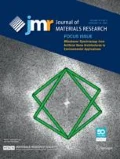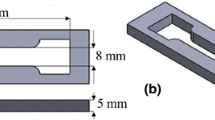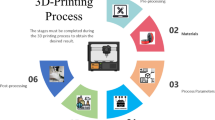Abstract
Vast improvements have been made to the capabilities of advanced manufacturing (AM), yet there are still limitations on which materials can effectively be used in the technology. To this end, parts created using AM would benefit from the ability to be developed from feedstock materials incorporating additional functionality. A common three-dimensional (3D) printing polymer, acrylonitrile butadiene styrene, was combined with bismuth and polyvinylidene fluoride via a solvent treatment to fabricate multifunctional composite materials for AM. Composites of varying weight percent loadings were extruded into filaments, which were subsequently 3D printed into blocks via fused filament fabrication. Investigating the material properties demonstrated that in addition to the printed blocks successfully performing as radiation shields, the chemical, thermal, and mechanical properties are suitable for AM. Thus, this work demonstrates that it is possible to enhance AM components with augmented capabilities while not significantly altering the material properties which make AM possible.







Similar content being viewed by others
References
M.K. Thompson, G. Moroni, T. Vaneker, G. Fadel, R.I. Campbell, I. Gibson, A. Bernard, J. Schulz, P. Graf, B. Ahuja, and F. Martina: Design for additive manufacturing: Trends, opportunities, considerations, and constraints. CIRP Ann.-Manuf. Techn.65, 737 (2016).
L.M. Maiyar, S. Singh, V. Prabhu, and M.K. Tiwari: Part segregation based on particle swarm optimisation for assembly design in additive manufacturing. Int. J. Comput. Integr. Manuf.32, 705 (2019).
J.R.C. Dizon, A.H. Espera, Q.Y. Chen, and R.C. Advincula: Mechanical characterization of 3D-printed polymers. Addit. Manuf.20, 44 (2018).
L. Szentmiklosi, B. Maroti, Z. Kis, J. Janik, and L.Z. Horvath: Use of 3D mesh geometries and additive manufacturing in neutron beam experiments. J. Radioanal. Nucl. Chem.320, 451 (2019).
M. Attaran: The rise of 3-D printing: The advantages of additive manufacturing over traditional manufacturing. Bus. Horiz.60, 677 (2017).
N.P. Levenhagen and M.D. Dadmun: Interlayer diffusion of surface segregating additives to improve the isotropy of fused deposition modeling products. Polymer152, 35 (2018).
B. Mooney, K.I. Kourousis, and R. Raghavendra: Plastic anisotropy of additively manufactured maraging steel: Influence of the build orientation and heat treatments. Addit. Manuf.25, 19–31 (2019).
N.P. Levenhagen and M.D. Dadmun: Bimodal molecular weight samples improve the isotropy of 3D printed polymeric samples. Polymer122, 232 (2017).
J.F. Christ, N. Aliheidari, A. Ameli, and P. Potschke: 3D printed highly elastic strain sensors of multiwalled carbon nanotube/ thermoplastic polyurethane nanocomposites. Mater. Design.131, 394 (2017).
E.Y. Teo, S.Y. Ong, M.S.K. Chong, Z.Y. Zhang, J. Lu, S. Moochhala, B. Ho, and S.H. Teoh: Polycaprolactone-based fused deposition modeled mesh for delivery of antibacterial agents to infected wounds. Biomaterials32, 279 (2011).
M. Alhijjaj, P. Belton, and S. Qi: An investigation into the use of polymer blends to improve the printability of and regulate drug release from pharmaceutical solid dispersions prepared via fused deposition modeling (FDM) 3D printing. Eur. J. Pharm. Biopharm.108, 111 (2016).
G. Kollamaram, D.M. Croker, G.M. Walker, A. Goyanes, A.W. Basit, and S. Gaisford: Low temperature fused deposition modeling (FDM) 3D printing of thermolabile drugs. Int. J. Pharm.545(1–2), 144 (2018).
J. Ceh, T. Youd, Z. Mastrovich, C. Peterson, S. Khan, T.A. Sasser, I.M. Sander, J. Doney, C. Turner, and W.M. Leevy: Bismuth infusion of ABS enables additive manufacturing of complex radiological phantoms and shielding equipment. Sensors (Basel)17(3), 459 (2017).
S. Woosley, N.A. Galehdari, A. Kelkar, and S. Aravamudhan: Fused deposition modeling 3D printing of boron nitride composites for neutron radiation shielding. J. Mater. Res.33, 3657 (2018).
G.P. Kar, S. Biswas, and S. Bose: X-ray micro computed tomography, segmental relaxation and crystallization kinetics in interfacial stabilized co-continuous immiscible PVDF/ABS blends. Polymer101, 291 (2016).
G.P. Kar, S. Biswas, and S. Bose: Simultaneous enhancement in mechanical strength, electrical conductivity, and electromagnetic shielding properties in PVDF-ABS blends containing PMMA wrapped multiwall carbon nanotubes. Phys. Chem. Chem. Phys.17, 14856 (2015).
S. Abdalla, A. Obaid, and F.M. Al-Marzouki: Preparation and characterization of poly(vinylidene fluoride): A high dielectric performance nano-composite for electrical storage. Results Phys.6, 617 (2016).
J. Liu, X. Shen, Y.P. Zhao, and L. Chen: Acryloylmorpholine-grafted PVDF membrane with improved protein fouling resistance. Ind. Eng. Chem. Res.52, 18392 (2013).
F. Liu, N.A. Hashim, Y.T. Liu, M.R.M. Abed, and K. Li: Progress in the production and modification of PVDF membranes. J. Membr. Sci.375, 1 (2011).
D. Lin-Vien, N.B. Colthup, W.G. Fateley, and J.G. Grasselli: Chapter 3 – Halocompounds. In The Handbook of Infrared and Raman Characteristic Frequencies of Organic Molecules, D. Lin-Vien, N.B. Colthup, W.G. Fateley, and J.G. Grasselli, eds. (Academic Press, San Diego, 1991); p. 29.
H. Guo, Y. Zhang, F. Xue, Z. Cai, Y. Shang, J. Li, Y. Chen, Z. Wu, and S. Jiang: In-situ synchrotron SAXS and WAXS investigations on deformation and α–β transformation of uniaxial stretched poly (vinylidene fluoride). Cryst. Eng. Comm.15, 1597 (2013).
Y. Wang and M. Cakmak: Spatial variation of structural hierarchy in injection molded PVDF and blends of PVDF with PMMA. Part II. Application of microbeam WAXS pole figure and SAXS techniques. Polymer42, 4233 (2001).
G. Beaucage: Approximations leading to a unified exponential/ power-law approach to small-angle scattering. J. Appl. Crystallogr.28, 717 (1995).
C. Beaucage and D.W. Schaefer: Structural studies of complex systems using small-angle scattering: A unified Guinier/power-law approach. J. Non-Cryst. Solids172, 797 (1994).
D.G. Archer: Enthalpy of fusion of bismuth: A certified reference material for differential scanning calorimetry. J. Chem. Eng. Data49, 1364 (2004).
C.D. Zou, Y.L. Gao, B. Yang, and Q.J. Zhai: Melting and undercooling of bismuth nanocrystals by solvothermal synthesis. Phys. B404, 4045 (2009).
D. Turnbull: Formation of crystal nuclei in liquid metals. J. Appl. Phys.21, 1022 (1950).
C. Marega and A. Marigo: Influence of annealing and chain defects on the melting behaviour of poly (vinylidene fluoride). Eur. Polym. J.39, 1713 (2003).
J. Feng, C. Carpanese, and A. Fina: Thermal decomposition investigation of ABS containing Lewis-acid type metal salts. Polym. Degrad. Stab.129, 319 (2016).
J.Y. Lee, Y.G. Liao, R. Nagahata, and S. Horiuchi: Effect of metal nanoparticles on thermal stabilization of polymer/metal nano-composites prepared by a one-step dry process. Polymer47, 7970 (2006).
S.M. Lebedev, O.S. Gefle, and S.N. Tkachenko: Metal polymer PVDF/nickel composites and evaluation of their dielectric and thermal properties. J. Electrostat.68, 122 (2010).
Z.W. Ouyang, E.C. Chen, and T.M. Wu: Thermal stability and magnetic properties of polyvinylidene fluoride/magnetite nano-composites. Materials8, 4553 (2015).
X. Jiang, C. Xu, Y. Wang, and Y. Chen: Polyvinylidene fluoride/ acrylonitrile butadiene rubber blends prepared via dynamic vulcanization. J. Macromol Sci. B54, 58 (2015).
W.F. Hosford:Mechanical Behavior of Materials (Cambridge University Press, New York, 2010).
A.H. El-Kateb, R.A.M. Rizk, and A.M. Abdul-Kader: Determination of atomic cross-sections and effective atomic numbers for some alloys. Ann. Nucl. Energy27, 1333 (2000).
A. Canel, H. Korkut, and T. Korkut: Improving neutron and gamma flexible shielding by adding medium-heavy metal powder to epoxy based composite materials. Radiat. Phys. Chem.158, 13 (2019).
I.I. Bashter: Calculation of radiation attenuation coefficients for shielding concretes. Ann. Nucl. Energy24, 1389 (1997).
S.J. Zinkle and G.S. Was: Materials challenges in nuclear energy. Acta Mater.61, 735 (2013).
J. Ilavsky, P.R. Jemian, A.J. Allen, F. Zhang, L.E. Levine, and G.G. Long: Ultra-small-angle X-ray scattering at the Advanced Photon Source. J. Appl. Crystallogr.42, 469 (2009).
J. Ilavsky: Nika: Software for two-dimensional data reduction. J. Appl. Crystallogr.45, 324 (2012).
J. Ilavsky and P.R. Jemian: Irena: Tool suite for modeling and analysis of small-angle scattering. J. Appl. Crystallogr.42, 347 (2009).
J.S. Temenoff, and A.G. Mikos:Biomaterials : The Intersection of Biology and Materials Science (Pearson/Prentice Hall, Upper Saddle River, 2008).
M.R. Kessler:Advanced Topics in Characterization of Composites (Trafford Publishing, Victoria, BC, Canada, 2004).
A.P. Gray: Polymer crystallinity determinations by DSC. Thermochimica Acta.16, 563–579 (1970).
K.M. Lu, W.J. Lee, W.H. Chen, and T.C. Lin: Thermogravimetric analysis and kinetics of co-pyrolysis of raw/torrefied wood and coal blends. Appl. Energy105, 57 (2013).
Acknowledgements
This work was performed under the U.S. Department of Energy’s National Nuclear Security Administration Contract No. DE-AC52-06NA25396. This research used resources of the Advanced Photon Source, the U.S. Department of Energy (DOE) Office of Science User Facility operated for the DOE Office of Science by Argonne National Laboratory under Contract No. DE-AC02-06CH11357. USAXS/SAXS data were collected on the 9-ID-C beamline at the APS, Argonne National Laboratory under General User Proposal number 64333. The authors thank Adam Pacheco for his technical support during this project.
Author information
Authors and Affiliations
Corresponding author
Rights and permissions
About this article
Cite this article
Brounstein, Z., Talley, S., Dumont, J.H. et al. Fused filament fabrication of polymer composites for extreme environments. Journal of Materials Research 35, 1493–1503 (2020). https://doi.org/10.1557/jmr.2020.118
Received:
Accepted:
Published:
Issue Date:
DOI: https://doi.org/10.1557/jmr.2020.118




